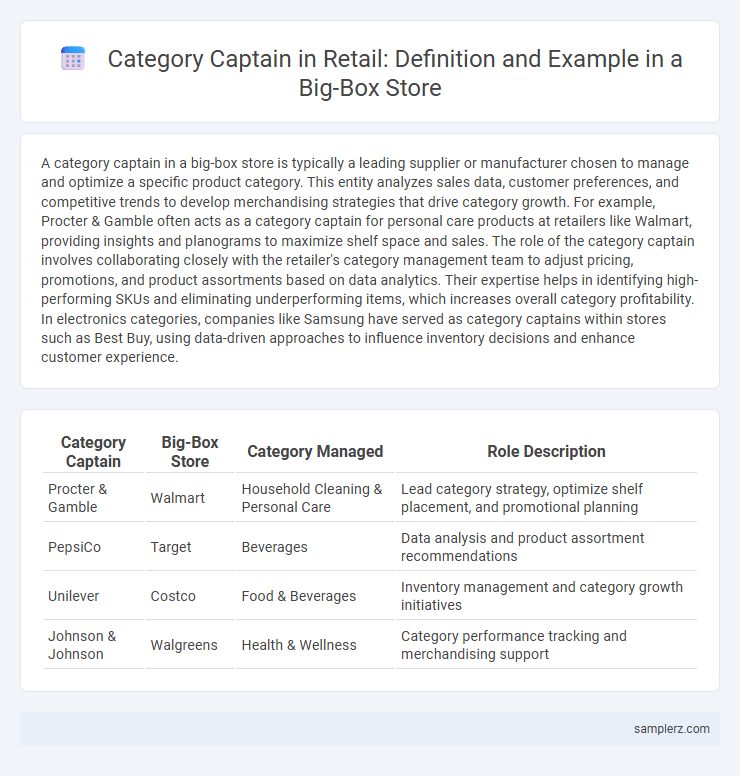A category captain in a big-box store is typically a leading supplier or manufacturer chosen to manage and optimize a specific product category. This entity analyzes sales data, customer preferences, and competitive trends to develop merchandising strategies that drive category growth. For example, Procter & Gamble often acts as a category captain for personal care products at retailers like Walmart, providing insights and planograms to maximize shelf space and sales. The role of the category captain involves collaborating closely with the retailer's category management team to adjust pricing, promotions, and product assortments based on data analytics. Their expertise helps in identifying high-performing SKUs and eliminating underperforming items, which increases overall category profitability. In electronics categories, companies like Samsung have served as category captains within stores such as Best Buy, using data-driven approaches to influence inventory decisions and enhance customer experience.
Table of Comparison
| Category Captain | Big-Box Store | Category Managed | Role Description |
|---|---|---|---|
| Procter & Gamble | Walmart | Household Cleaning & Personal Care | Lead category strategy, optimize shelf placement, and promotional planning |
| PepsiCo | Target | Beverages | Data analysis and product assortment recommendations |
| Unilever | Costco | Food & Beverages | Inventory management and category growth initiatives |
| Johnson & Johnson | Walgreens | Health & Wellness | Category performance tracking and merchandising support |
Understanding the Role of a Category Captain in Big-Box Retail
A category captain in big-box retail partners closely with store management to analyze sales data, optimize product assortments, and develop strategic merchandising plans that drive category growth. This role involves leveraging consumer insights and market trends to improve shelf placement, pricing strategies, and promotional activities, enhancing overall category performance. Effective category captains help align manufacturer and retailer goals, ensuring mutual benefit through increased sales, better inventory management, and improved customer satisfaction.
Key Responsibilities of Category Captains in Major Stores
Category Captains in big-box stores oversee product assortment, pricing strategies, and shelf placement to maximize sales and profitability. They analyze consumer behavior and market trends to recommend inventory adjustments and promotional activities tailored to the store's demographics. Collaborating closely with suppliers and store managers, they ensure optimal in-store execution and Category Management success.
Top Examples of Category Captains in Big-Box Retailers
Top examples of category captains in big-box retailers include Procter & Gamble at Walmart, driving strategic product placement and promotional planning to increase household care sales. Coca-Cola serves as a category captain at Target, optimizing beverage assortments and shopper insights to boost category performance. Kimberly-Clark partners with Costco, leveraging data analytics to enhance paper goods merchandising and inventory management.
How Category Captains Influence Product Assortment
Category captains in big-box stores like Walmart analyze sales data and consumer behavior to recommend optimal product assortments that drive category growth and profitability. They collaborate with retailers to prioritize high-margin and high-demand products, ensuring shelves reflect the latest trends and seasonal preferences. This strategic influence helps streamline inventory, reduce stockouts, and improve overall shopper satisfaction.
Leading Brands That Serve as Category Captains in Big-Box Stores
Leading brands such as Procter & Gamble in personal care and Coca-Cola in beverages serve as category captains in big-box stores like Walmart and Target, leveraging extensive market data and consumer insights to optimize shelf placement and promotions. These category captains collaborate closely with retailers to implement strategic planograms, driving category growth and enhancing shopper experience through tailored product assortments. Their dominant market share and strong supplier-retailer partnerships enable them to influence category management decisions effectively in highly competitive retail environments.
The Selection Process for Category Captains in Retail Chains
Retail chains select category captains through a rigorous evaluation of suppliers' market expertise, sales performance, and ability to drive category growth within big-box stores. Criteria include data analytics capabilities, collaborative planning skills, and a proven track record in inventory management and promotional effectiveness. The selection process emphasizes alignment with the retailer's strategic goals and the capacity to influence category assortment, pricing, and merchandising decisions.
Impact of Category Captaincy on Store Layout and Merchandising
In big-box retail stores, category captains like Procter & Gamble significantly influence store layout and merchandising by optimizing product placement based on consumer behavior data, which improves shelf organization and enhances shopper experience. Their strategic insights lead to increased product visibility and sales by aligning product assortments with shopper preferences and seasonal trends. Effective category captaincy drives collaboration between manufacturers and retailers, resulting in tailored planograms that maximize space efficiency and boost overall category performance.
Collaboration Between Big-Box Retailers and Category Captains
Big-box retailers collaborate with category captains by sharing detailed sales data and consumer insights to optimize product assortment and shelf placement. Category captains leverage this information to develop tailored merchandising strategies that drive category growth and improve customer shopping experiences. This partnership enhances inventory management and promotional effectiveness, resulting in increased sales and market share for both parties.
Metrics Used to Evaluate Category Captain Performance
Category captains in big-box retail stores are evaluated using key metrics such as sales growth, inventory turnover rates, and shelf space productivity to measure their impact on category performance. Market share improvements and alignment with promotional effectiveness also serve as critical indicators of a category captain's strategic influence. Consumer satisfaction scores and planogram compliance rates provide additional insights into operational execution and shopper engagement.
Future Trends for Category Captains in the Big-Box Retail Industry
Category captains in big-box retail are increasingly leveraging advanced data analytics and artificial intelligence to optimize product assortments, pricing strategies, and shelf placement based on real-time consumer behavior. Enhanced collaboration between retailers and manufacturers enables predictive inventory management, reducing stockouts and excess inventory while improving shopper satisfaction. Emerging trends highlight the integration of omnichannel insights and sustainable product offerings as key drivers for future category captain success.

example of category captain in big-box store Infographic
 samplerz.com
samplerz.com